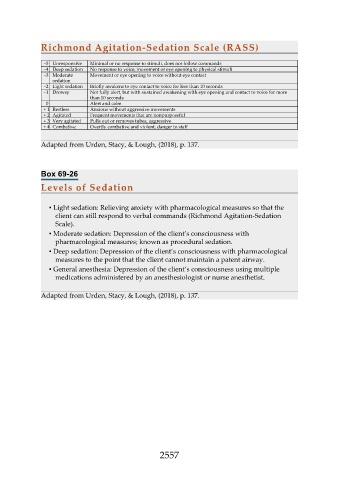Page 2557 - Saunders Comprehensive Review For NCLEX-RN
P. 2557
Richmond Agitation-Sedation Scale (RASS)
−5 Unresponsive Minimal or no response to stimuli, does not follow commands
−4 Deep sedation No response to voice, movement or eye opening to physical stimuli
−3 Moderate Movement or eye opening to voice without eye contact
sedation
−2 Light sedation Briefly awakens to eye contact to voice for less than 10 seconds
−1 Drowsy Not fully alert, but with sustained awakening with eye opening and contact to voice for more
than 10 seconds
0 Alert and calm
+ 1 Restless Anxious without aggressive movements
+ 2 Agitated Frequent movements that are nonpurposeful
+ 3 Very agitated Pulls out or removes tubes, aggressive
+ 4 Combative Overtly combative and violent, danger to staff
Adapted from Urden, Stacy, & Lough, (2018), p. 137.
Box 69-26
Levels of Sedation
▪ Light sedation: Relieving anxiety with pharmacological measures so that the
client can still respond to verbal commands (Richmond Agitation-Sedation
Scale).
▪ Moderate sedation: Depression of the client’s consciousness with
pharmacological measures; known as procedural sedation.
▪ Deep sedation: Depression of the client’s consciousness with pharmacological
measures to the point that the client cannot maintain a patent airway.
▪ General anesthesia: Depression of the client’s consciousness using multiple
medications administered by an anesthesiologist or nurse anesthetist.
Adapted from Urden, Stacy, & Lough, (2018), p. 137.
2557

